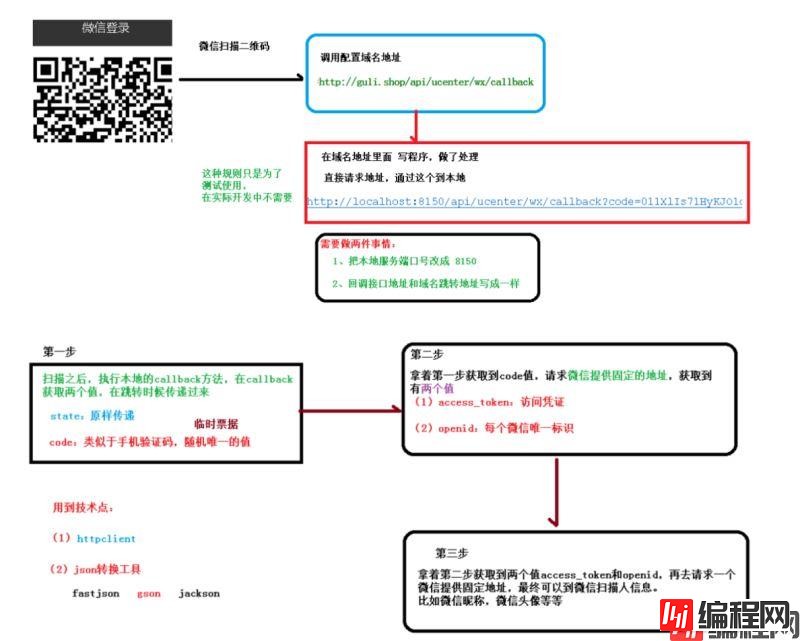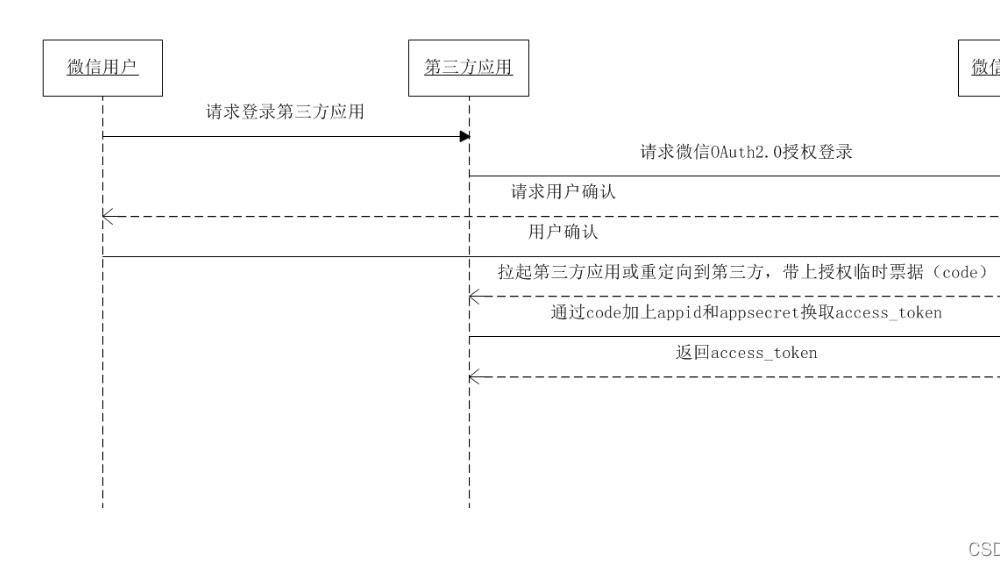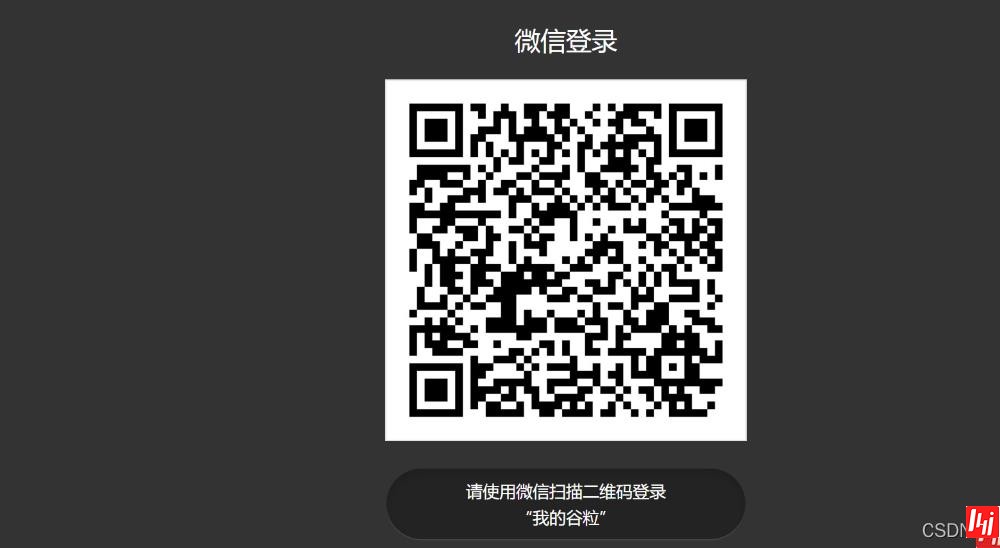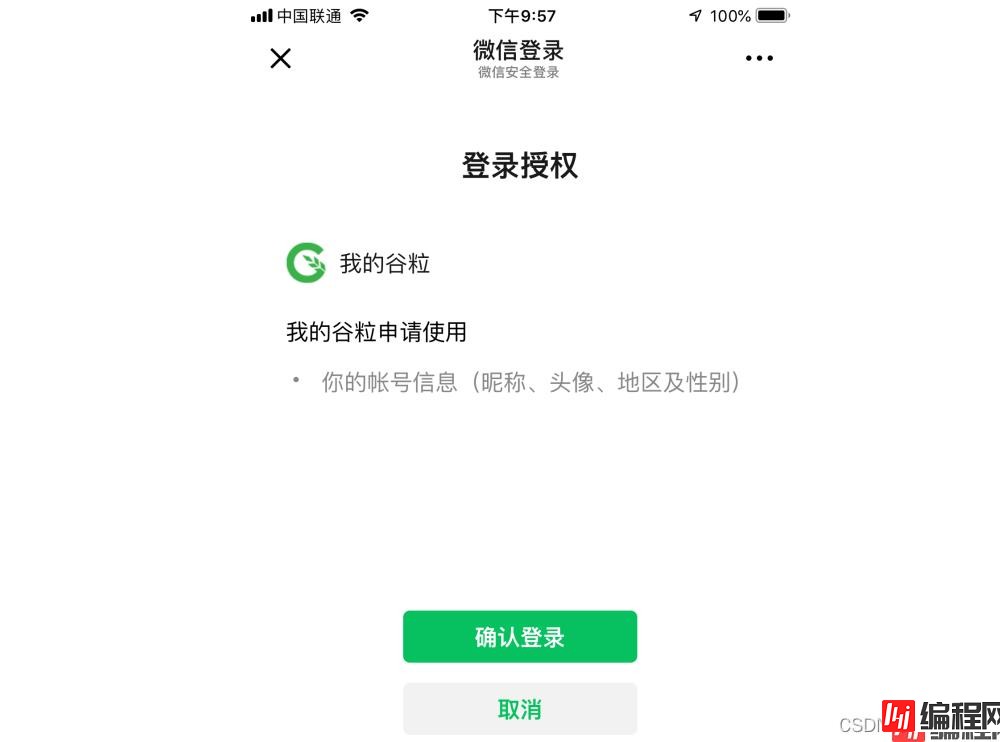Python 官方文档:入门教程 => 点击学习
目录1.准备工作1.1 获取微信登录凭证1.2 配置文件1.3 添加依赖1.4 创建读取公共常量的工具类1.5 HttpClient工具类2.实现微信登录2.1 具体流程2.2 生成
前往官网微信开放平台 (qq.com),完成以下步骤:
1.注册
2.邮箱激活
3.完善开发者资料
4.开发者资质认证
5.创建网站应用
在配置文件application.properties添加相关配置信息:
# 微信开放平台 appid
wx.open.app_id=你的appid
# 微信开放平台 appsecret
wx.open.app_secret=你的appsecret
# 微信开放平台重定向url
wx.open.redirect_url=http://81/api/ucenter/wx/callback
<!--httpclient-->
<dependency>
<groupId>org.apache.httpcomponents</groupId>
<artifactId>httpclient</artifactId>
</dependency>
<!--commons-io-->
<dependency>
<groupId>commons-io</groupId>
<artifactId>commons-io</artifactId>
</dependency>
<!--gson-->
<dependency>
<groupId>com.Google.code.gson</groupId>
<artifactId>gson</artifactId>
</dependency>
创建读取公共常量的工具类ConstantWxUtils:
@Component
public class ConstantWxUtils implements InitializingBean {
@Value("${wx.open.app_id}")
private String appId;
@Value("${wx.open.app_secret}")
private String appSecret;
@Value("${wx.open.redirect_url}")
private String redirectUrl;
public static String WX_OPEN_APP_ID;
public static String WX_OPEN_APP_SECRET;
public static String WX_OPEN_REDIRECT_URL;
@Override
public void afterPropertiesSet() throws Exception {
WX_OPEN_APP_ID = appId;
WX_OPEN_APP_SECRET = appSecret;
WX_OPEN_REDIRECT_URL = redirectUrl;
}
}
public class HttpClientUtils {
public static final int connTimeout=10000;
public static final int readTimeout=10000;
public static final String charset="UTF-8";
private static HttpClient client = null;
static {
PoolingHttpClientConnectionManager cm = new PoolingHttpClientConnectionManager();
cm.setMaxTotal(128);
cm.setDefaultMaxPerRoute(128);
client = HttpClients.custom().setConnectionManager(cm).build();
}
public static String postParameters(String url, String parameterStr) throws ConnectTimeoutException, SocketTimeoutException, Exception{
return post(url,parameterStr,"application/x-www-fORM-urlencoded",charset,connTimeout,readTimeout);
}
public static String postParameters(String url, String parameterStr,String charset, Integer connTimeout, Integer readTimeout) throws ConnectTimeoutException, SocketTimeoutException, Exception{
return post(url,parameterStr,"application/x-www-form-urlencoded",charset,connTimeout,readTimeout);
}
public static String postParameters(String url, Map<String, String> params) throws ConnectTimeoutException,
SocketTimeoutException, Exception {
return postForm(url, params, null, connTimeout, readTimeout);
}
public static String postParameters(String url, Map<String, String> params, Integer connTimeout,Integer readTimeout) throws ConnectTimeoutException,
SocketTimeoutException, Exception {
return postForm(url, params, null, connTimeout, readTimeout);
}
public static String get(String url) throws Exception {
return get(url, charset, null, null);
}
public static String get(String url, String charset) throws Exception {
return get(url, charset, connTimeout, readTimeout);
}
public static String post(String url, String body, String mimeType,String charset, Integer connTimeout, Integer readTimeout)
throws ConnectTimeoutException, SocketTimeoutException, Exception {
HttpClient client = null;
HttpPost post = new HttpPost(url);
String result = "";
try {
if (StringUtils.isNotBlank(body)) {
HttpEntity entity = new StringEntity(body, ContentType.create(mimeType, charset));
post.setEntity(entity);
}
// 设置参数
Builder customReqConf = RequestConfig.custom();
if (connTimeout != null) {
customReqConf.setConnectTimeout(connTimeout);
}
if (readTimeout != null) {
customReqConf.setSocketTimeout(readTimeout);
}
post.setConfig(customReqConf.build());
HttpResponse res;
if (url.startsWith("https")) {
// 执行 Https 请求.
client = createSSLInsecureClient();
res = client.execute(post);
} else {
// 执行 Http 请求.
client = HttpClientUtils.client;
res = client.execute(post);
}
result = IOUtils.toString(res.getEntity().getContent(), charset);
} finally {
post.releaseConnection();
if (url.startsWith("https") && client != null&& client instanceof CloseableHttpClient) {
((CloseableHttpClient) client).close();
}
}
return result;
}
public static String postForm(String url, Map<String, String> params, Map<String, String> headers, Integer connTimeout,Integer readTimeout) throws ConnectTimeoutException,
SocketTimeoutException, Exception {
HttpClient client = null;
HttpPost post = new HttpPost(url);
try {
if (params != null && !params.isEmpty()) {
List<NameValuePair> formParams = new ArrayList<NameValuePair>();
Set<Entry<String, String>> entrySet = params.entrySet();
for (Entry<String, String> entry : entrySet) {
formParams.add(new BasicNameValuePair(entry.geTKEy(), entry.getValue()));
}
UrlEncodedFormEntity entity = new UrlEncodedFormEntity(formParams, Consts.UTF_8);
post.setEntity(entity);
}
if (headers != null && !headers.isEmpty()) {
for (Entry<String, String> entry : headers.entrySet()) {
post.addHeader(entry.getKey(), entry.getValue());
}
}
// 设置参数
Builder customReqConf = RequestConfig.custom();
if (connTimeout != null) {
customReqConf.setConnectTimeout(connTimeout);
}
if (readTimeout != null) {
customReqConf.setSocketTimeout(readTimeout);
}
post.setConfig(customReqConf.build());
HttpResponse res = null;
if (url.startsWith("https")) {
// 执行 Https 请求.
client = createSSLInsecureClient();
res = client.execute(post);
} else {
// 执行 Http 请求.
client = HttpClientUtils.client;
res = client.execute(post);
}
return IOUtils.toString(res.getEntity().getContent(), "UTF-8");
} finally {
post.releaseConnection();
if (url.startsWith("https") && client != null
&& client instanceof CloseableHttpClient) {
((CloseableHttpClient) client).close();
}
}
}
public static String get(String url, String charset, Integer connTimeout,Integer readTimeout)
throws ConnectTimeoutException,SocketTimeoutException, Exception {
HttpClient client = null;
HttpGet get = new HttpGet(url);
String result = "";
try {
// 设置参数
Builder customReqConf = RequestConfig.custom();
if (connTimeout != null) {
customReqConf.setConnectTimeout(connTimeout);
}
if (readTimeout != null) {
customReqConf.setSocketTimeout(readTimeout);
}
get.setConfig(customReqConf.build());
HttpResponse res = null;
if (url.startsWith("https")) {
// 执行 Https 请求.
client = createSSLInsecureClient();
res = client.execute(get);
} else {
// 执行 Http 请求.
client = HttpClientUtils.client;
res = client.execute(get);
}
result = IOUtils.toString(res.getEntity().getContent(), charset);
} finally {
get.releaseConnection();
if (url.startsWith("https") && client != null && client instanceof CloseableHttpClient) {
((CloseableHttpClient) client).close();
}
}
return result;
}
@SuppressWarnings("unused")
private static String getCharsetFromResponse(HttpResponse ressponse) {
// Content-Type:text/html; charset=GBK
if (ressponse.getEntity() != null && ressponse.getEntity().getContentType() != null && ressponse.getEntity().getContentType().getValue() != null) {
String contentType = ressponse.getEntity().getContentType().getValue();
if (contentType.contains("charset=")) {
return contentType.substring(contentType.indexOf("charset=") + 8);
}
}
return null;
}
private static CloseableHttpClient createSSLInsecureClient() throws GeneralSecurityException {
try {
SSLContext sslContext = new SSLContextBuilder().loadTrustMaterial(null, new TrustStrategy() {
public boolean isTrusted(X509Certificate[] chain,String authType) throws CertificateException {
return true;
}
}).build();
SSLConnectionSocketFactory sslsf = new SSLConnectionSocketFactory(sslContext, new X509HostnameVerifier() {
@Override
public boolean verify(String arg0, SSLSession arg1) {
return true;
}
@Override
public void verify(String host, SSLSocket ssl)
throws IOException {
}
@Override
public void verify(String host, X509Certificate cert)
throws SSLException {
}
@Override
public void verify(String host, String[] cns,
String[] subjectAlts) throws SSLException {
}
});
return HttpClients.custom().setSSLSocketFactory(sslsf).build();
} catch (GeneralSecurityException e) {
throw e;
}
}
public static void main(String[] args) {
try {
String str= post("https://localhost:443/ssl/test.shtml","name=12&page=34","application/x-www-form-urlencoded", "UTF-8", 10000, 10000);
//String str= get("https://localhost:443/ssl/test.shtml?name=12&page=34","GBK");
System.out.println(str);
} catch (ConnectTimeoutException e) {
// TODO Auto-generated catch block
e.printStackTrace();
} catch (SocketTimeoutException e) {
// TODO Auto-generated catch block
e.printStackTrace();
} catch (Exception e) {
// TODO Auto-generated catch block
e.printStackTrace();
}
}
}
可以参考官方文档:[网站应用微信登录开发指南](准备工作 | 微信开放文档 (qq.com))

获取access_token时序图:

controller层:
@CrossOrigin
@Controller
@RequestMapping("/api/ucenter/wx")
public class WxApiController {
@Autowired
private UcenterMemberService memberService;
@GetMapping("login")
public String getWxCode() {
//微信开放平台授权baseUrl
String baseUrl = "https://open.weixin.qq.com/connect/qrconnect" +
"?appid=%s" +
"&redirect_uri=%s" +
"&response_type=code" +
"&scope=snsapi_login" +
"&state=%s" +
"#wechat_redirect";
//对redirect_url进行URLEncoder编码
String redirectUrl = ConstantWxUtils.WX_OPEN_REDIRECT_URL;
try {
redirectUrl = URLEncoder.encode(redirectUrl, "UTF-8");
} catch (UnsupportedEncodingException e) {
throw new GuliException(20001, e.getMessage());
}
//设置%s的值
String url = String.format(
baseUrl,
ConstantWxUtils.WX_OPEN_APP_ID,
redirectUrl,
"atguigu"
);
//重定向到请求微信地址
return "redirect:" + url;
}
}
访问:http://localhost:8160/api/ucenter/wx/login
访问授权url后会得到一个微信登录二维码:

用户扫描二维码会看到确认登录的页面:

用户点击“确认登录”后,微信服务器会向谷粒学院的业务服务器发起回调,因此接下来我们需要开发回调controller
具体分几步:
1.通过code获取access_token
https://api.weixin.qq.com/sns/oauth2/access_token?appid=APPID&secret=SECRET&code=CODE&grant_type=authorization_code
| 参数 | 是否必须 | 说明 |
|---|---|---|
| appid | 是 | 应用唯一标识,在微信开放平台提交应用审核通过后获得 |
| secret | 是 | 应用密钥AppSecret,在微信开放平台提交应用审核通过后获得 |
| code | 是 | 填写第一步获取的code参数 |
| grant_type | 是 | 填authorization_code |
2.从返回结果获取两个值access_token、openid
3.通过openid查询数据库判断该用户是不是第一次登录
4.如果是第一次登录,根据access_token和openid再去访问微信的资源服务器,获取用户信息,存入数据库
5.使用Jwt根据member对象生成token字符串,最后返回首页面,通过路径传递token字符串
@GetMapping("callback")
public String callback(String code, String state) {
try {
//获取code值,临时票据类似于验证码
//拿着code请求微信固定的地址,得到两个值
//1.向认证服务器发送请求换取access_token
String baseAccessTokenUrl =
"https://api.weixin.qq.com/sns/oauth2/access_token" +
"?appid=%s" +
"&secret=%s" +
"&code=%s" +
"&grant_type=authorization_code";
//拼接三个参数:id 密钥 和 code值
String accessTokenUrl = String.format(
baseAccessTokenUrl,
ConstantWxUtils.WX_OPEN_APP_ID,
ConstantWxUtils.WX_OPEN_APP_SECRET,
code
);
//2.请求拼接好的地址,得到返回的两个值access_token和openid
//使用httpclient发送请求,得到返回结果(JSON形式的字符串)
String accessTokenInfo = HttpClientUtils.get(accessTokenUrl);
//从accessTokenInfo字符串获取两个值access_token、openid
//把accessTokenInfo字符串转换为map集合,根据map里面的key获取值
//这里使用json转换工具Gson
Gson gson = new Gson();
HashMap accessTokenMap = gson.fromJson(accessTokenInfo, HashMap.class);
String access_token = (String) accessTokenMap.get("access_token");
String openid = (String) accessTokenMap.get("openid");
//3.判断该用户是不是第一次扫码登录
//通过openid判断
UcenterMember member = memberService.getOpenIdMember(openid);
//4.只有第一次登录才获取信息
if (member == null) {
//根据access_token和openid再去访问微信的资源服务器,获取用户信息
String baseUserInfoUrl = "https://api.weixin.qq.com/sns/userinfo" +
"?access_token=%s" +
"&openid=%s";
String userInfoUrl = String.format(
baseUserInfoUrl,
access_token,
openid
);
//发送请求,得到用户信息
String userInfo = HttpClientUtils.get(userInfoUrl);
System.out.println(userInfo);
//将用户信息存入数据库
//把json转换为map
HashMap userInfoMap = gson.fromJson(userInfo, HashMap.class);
//得到nickname
String nickname = (String) userInfoMap.get("nickname");
//得到微信头像avatar
String headimgurl = (String) userInfoMap.get("headimgurl");
member = new UcenterMember();
member.setOpenid(openid);
member.setNickname(nickname);
member.setAvatar(headimgurl);
memberService.save(member);
}
//5.使用jwt根据member对象生成token字符串
String jwtToken = JwtUtils.getJwtToken(member.getId(), member.getNickname());
//最后返回首页面,通过路径传递token字符串
return "redirect:http://localhost:3000?token=" + jwtToken;
} catch (Exception e) {
throw new GuliException(20001, "微信登录失败");
}
}
判断该用户是不是第一次扫码登录
以上就是详解SpringBoot如何实现整合微信登录的详细内容,更多关于springBoot整合微信登录的资料请关注编程网其它相关文章!
--结束END--
本文标题: 详解SpringBoot如何实现整合微信登录
本文链接: https://www.lsjlt.com/news/160535.html(转载时请注明来源链接)
有问题或投稿请发送至: 邮箱/279061341@qq.com QQ/279061341
下载Word文档到电脑,方便收藏和打印~
2024-03-01
2024-03-01
2024-03-01
2024-02-29
2024-02-29
2024-02-29
2024-02-29
2024-02-29
2024-02-29
2024-02-29
回答
回答
回答
回答
回答
回答
回答
回答
回答
回答
0